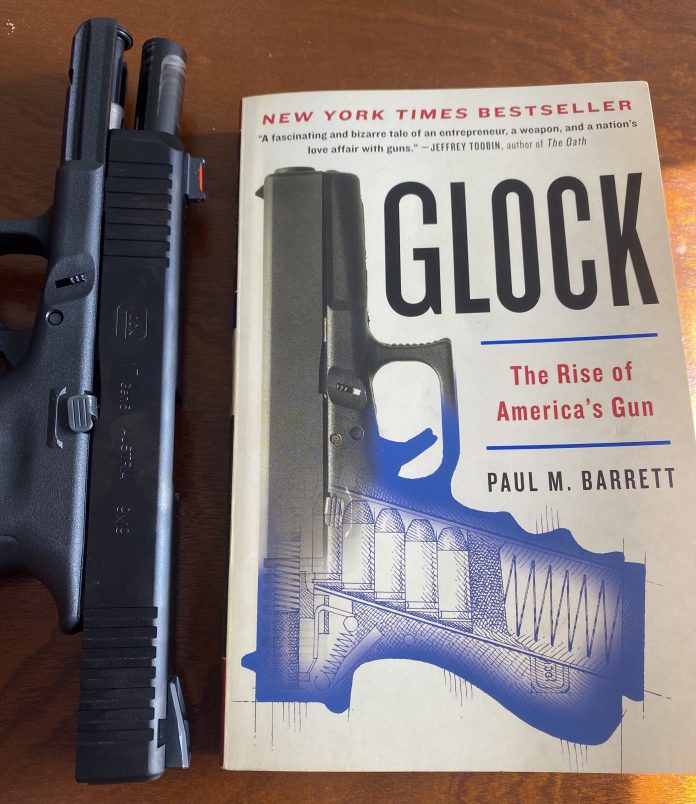
I picked up a copy of Glock: The Rise Of America’s Gun while perusing through a used bookstore recently. This well-researched book about the Austrian firm’s prolific product line is a fascinating and easy weekend read for anyone interested in the general history of Glock or American gun culture. Unexpectedly, of the elements about the company’s history and its players do read like part of a thriller novel. Though Glock was published in 2013, ten years ago by Author Paul M. Barrett, its story is most definitely not out of date. Glock’s primary focus, after all, is on the rise of the company and its key stakeholders with an emphasis on the first fifteen years of business.
I have been carrying and training extensively with 9mm Glock pistols including the 17, 19, 34, 45 and 48 ever since I became more “serious” about firearms training. Given my personal history and context with Glock products, reaching to grab a copy of this book off the shelf was not a difficult decision. Frankly, when I started reading this title, I had no expectations as to whether the author would have any bias in favor or against guns or the Second Amendment. After reading it cover to cover, I was pleasantly surprised to see that the author’s tone was overall neutral.
Being somewhat familiar with the genesis of the Glock pistol’s saga, this book did a great job to help fill in some knowledge gaps with additional details. (For example, I had no idea that the Beretta 92F almost became Austria’s P80 military pistol during the early 1980s). However, what I liked the most about this book [and what I think makes it a worthwhile read to those beyond the fans of Gaston’s plastic Perfection] is the fact that Barrett does a wonderful job chronicling the last fifteen years of the 20th century and how it related to the ever-changing political and market environments of the American gun world. The first chapter opens up with the infamous 1986 Miami FBI gunfight. Barrett sheds details of the rise of the “wonder nines” and the demise of the service revolver in American policing. Coupled with the young company’s competitive pricing and proactive sales tactics, the timing for the Glock’s entry into the handgun market could not have been better either. It wasn’t just with the Glock 17. Models like the Beretta 92 and the SIG-Sauer P22x series (along with the 9mm Luger cartridge) were making waves and leaving older .38 Special and .357 Magnum service revolvers in the past. When discussing the role of Glocks in crime and “gangster culture” I was surprised to learn that at the time of the current data when the book was written, Glock weapons were not as popular as rap songs and film references portrayed them amongst the criminal element.
The book also takes the reader (or reminds them, if they were old enough) through the tumultuous political times of 1990s gun politics: George H.W. Bush’s bans of Chinese and Russian imports, the 1994 Assault Weapons ban and its fall out, the Right to Carry Movement, etc. Naturally, these events are described from the perspective of the Austrian gun company and how it was affected for better or worse. Barrett also delves into the quotidian aspect of American gun culture and how normal Americans interface with firearms such as Glock handguns and the rest. He describes shooting an IDPA match as a guest of the notable firearms personality, Massad Ayoob. Lastly, Glock is interwoven with personal aspects of all of the key players of Glock, Inc. As he does with the topic of guns and gun culture, Barrett also remains neutral when reporting about facts, allegations, scandals and controversies the firm and its operatives have dealt with over the years.
For those who are looking for a technical text, this book is not necessarily the best tome for in-depth discussions on technical information, design or development of Glock handguns. However, Barrett does an adequate job in explaining the basic function and design highlights of the handguns. The page opposite the first page of the first chapter is decorated with a cut-away diagram of a Glock 23 handgun, and the level of technical detail is perfect for the tone, style and scope of this book. With regards to the succinct technical coverage, my personal favorite aspect is the fact that Barrett illustrates how Glock’s pistols work on the same concept developed by genius John M. Browning: his recoil delayed blowback mechanism.
At the end of the day, the most fascinating aspect about the Glock story is that a small company with no prior firearms manufacturing experience was able to revolutionize the modern handgun market in such a short period of time. In doing so, the company went from being a provincial mom-and-pop operation to becoming a wealthy global leader in the gun industry. Glock’s impact on the gun world is such that now about every major gun company sells a polymer framed striker fired pistol in duty, compact, and sub-compact sizes.



